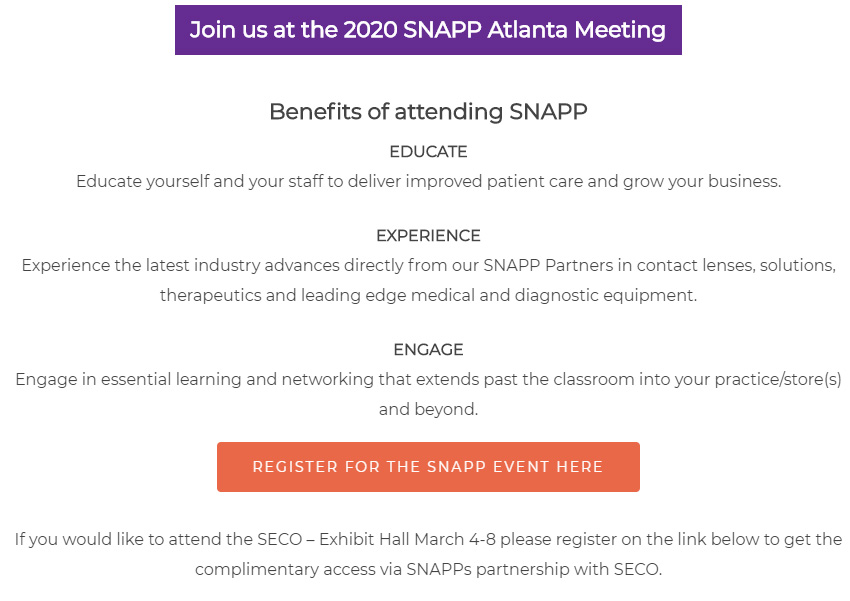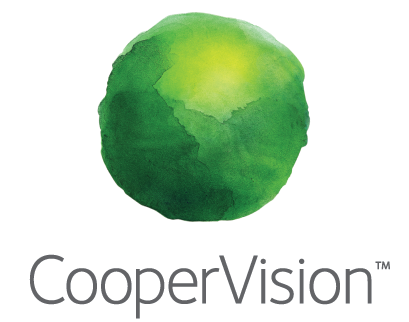

Best Wishes for a Wonderful 2020 From Your SNAPP Board
Call them resolutions, projections, goals, or plans; the start of a new year is a great time for looking back, as well as looking forward. What can you do in the upcoming months that you may have started—or put off —in 2019? How can next year be better than last year?
When asked, here’s what the SNAPP board members had to say…

Tracking Progress—Richard Hults, OD
It’s been my experience that the things we measure tend to improve… Without knowing where you’ve been, it’s difficult to know where you’re going and how to make plans to get there. In order to improve on our 2019 performance, we will dive deeper into tracking key indicators such as volume of complete patient exams, number of complete contact lens exams and capture rate (the # of complete pairs of eye wear sold divided by the number of exams that end in a prescription for eyewear.).
Sharing these metrics with office leadership helps these key personnel visualize where the opportunities may exist. I find it critical to pull staff members into the discussion to ensure “buy-in” and provide insight on why some days are more productive than others and how to remedy that.
I’ll be curious to hear from my colleagues what key metrics they collect and how they plan to use those for 2020 improvements. Looking forward to seeing everyone in Atlanta!

Increasing Business and Improving Service—Milissa Stone
For me, this time of year is always a great time to reflect on the year closing—what went well, what went poorly—and look at the upcoming year with some growth strategies. We are focusing on several areas in my store for improvement in 2020:
• Growing customer count
• Improving retention
• Dealing with disruptors in our industry and continuing to combat online sales
• Creating more effective communication between patient/staff and doctor
Attending SNAPP national meetings twice a year gives me an opportunity to interact with colleagues, learn and share. The speakers and sponsors provide information and products to improve my business and take it to the next level!

Integrating Wellness Into My Practice and My Life—Lisa Hamilton, OD
While I don’t normally make New Year’s resolutions, I’m becoming so passionate about health and wellness that I will make a resolution to become more educated about all aspects of health and wellness. I’m exploring topics in functional medicine, functional optometry, nutrition and dietary supplementation to see how I might be able to incorporate those elements into my practice for the benefit of my patients.
I’ve come to realize that achieving 20/20 visual acuity really should be the beginning of my patient’s eye care journey. In my work with glaucoma and dry eye disease patients, as well as with kids for whom vision is critical to their learning and development, I’m beginning to broaden my perspective and address all of my patients’ visual needs.
I’m looking forward to hearing from my Pearle colleagues at the SNAPP meeting in Atlanta on how they’re incorporating health and wellness into their practices. I’d also like to hear from our sponsor partners who may have gathered best-practices strategies with their products and services.

Making Professional and Personal Resolutions—Ken Kopolow, OD
My 2020 goals are a mix of professional and personal strategies. To improve our value to our patients, we will work hard to execute our functional vision platform. To enhance our profitability and appeal to patients and customers, we will also be refining changes we are making to our retail sales strategy.
On the personal side, I will continue to monitor my key personal health indicators and reduce the amount of time spent watching Fox News. To be the best optometrist and business owner that I can be, I have to be attentive to my own stress levels and health.
Share Your Resolutions
Send us your business or personal priorities for 2020. Your ideas may inspire others.

Efficiency = Profitable Rewards—David P. Kovar, Franchise Owner, Omaha, Nebraska
My New Year’s resolution is to spend time looking into and fixing day-to-day operational inefficiencies. The goal is to pay for a family vacation with the profits as a little reward.

Registration for SNAPP Atlanta Meeting Opening Soon
Be sure to check for updates on the program (snappgroup.org/atlanta-2020/); registration page will be opening soon.


Are You Required to Pay Overtime to Employees Who Work on Holidays?
Tip of the Month from AmCheck
There is no federal law that requires an employer to pay extra to employees who work on holidays. In many states, whether you pay extra for work done on holidays is up to you. However, some states, such as Massachusetts, require work for certain employers on holidays to be voluntary and paid at time-and-a-half.
As for overtime, if an employee has already worked 40 hours during that workweek and then works on a holiday, the holiday should be paid at the applicable overtime rate.
While usually not required by law, offering additional pay for work on holidays can be a nice financial incentive and reward. Here are a few suggestions for doing so.
• Pay time-and-a-half or double time for all hours worked on the holiday;
• Add an extra eight hours to the checks of employees who worked; or
• Place eight hours into a “floating holiday” bank for employees who worked so they can take time off at a later date.
If you decide to provide additional pay for holidays, be sure to do so in a non-discriminatory and consistent manner for all employees.

Important Insurance Changes Coming in 2020

By Shane Shepherd, Sr. Insurance Sales Manager, VisionWeb
1. Medicare Policy Number
Medicare has sent new cards, containing a new policy number, to its members. The old number utilized the patient’s Social Security Number. In 2020, the new policy number will not reference this sensitive information. The provider can submit claims using either number until Jan. 1, 2020. However, when the new year begins, Medicare will only accept claims with the new number. It is based on the date of submission, not the date of service. The only exceptions to this would be claims that need to be appealed or adjusted after processing in 2019.
2. Extended Ophthalmoscopy
The traditional extended ophthalmoscopy codes, 92225 (initial) and 92226 (subsequent), will be retired. In their place, two new codes that differ based on location rather than the timing will be introduced.
The new codes are
92201: Ophthalmoscopy, extended; with retinal drawing and scleral depression of peripheral retinal disease with interpretation and report, unilateral or bilateral
92202: Ophthalmoscopy, extended; with drawing of optic nerve or macula with interpretation and report, unilateral or bilateral
3. Additional Cataract Surgery Codes
In addition to the current codes of 66982 and 66984, the surgeon may use
66987: Extracapsular cataract removal with insertion of intraocular lens, manual or mechanical technique, complex, requiring devices or techniques not generally used in routine cataract surgery or performed on patients in the amblyogenic developmental stage; with endoscopic cyclophotocoagulation
66988: Extracapsular cataract removal with insertion of intraocular lens prosthesis, manual or mechanical technique with endoscopic cyclophotocoagulation.
The difference between the new codes and the old codes are that the new codes include endoscopic cyclophotocoagulation, while the old codes do not. The surgeon is the individual selecting these codes initially, but it will be important for your post-op claims to match.
4. Diabetes: Eye Exam
The Quality Measure Code for Diabetes: Eye Exam has been reported by selecting one (1) of four (4) codes. 2022F, 2024F, 2026F, and 3072F. 3072F has been used to indicate “Low risk for retinopathy (no evidence of retinopathy in the prior year)” and will stay the same. However, the other three did not include info related to whether retinopathy was present. That will change in 2020. The current codes will now include the verbiage “with evidence of retinopathy” and there will be three new codes to cover the lack of retinopathy. To summarize, there will be 7 codes for this measure. They are
3072F: Low risk for retinopathy (no evidence of retinopathy in the prior year)
2022F: Dilated retinal eye exam with interpretation by an ophthalmologist or optometrist documented and reviewed; with evidence of retinopathy (DM)
2023F: Dilated retinal eye exam with interpretation by an ophthalmologist or optometrist documented and reviewed; without evidence of retinopathy (DM)
2024F: 7 standard field stereoscopic retinal photos with interpretation by an ophthalmologist or optometrist documented and reviewed; with evidence of retinopathy (DM)
2025F: 7 standard field stereoscopic retinal photos with interpretation by an ophthalmologist or optometrist documented and reviewed; without evidence of retinopathy (DM)
2026F: Eye imaging validated to match diagnosis from 7 standard field stereoscopic retinal photos results documented and reviewed; with evidence of retinopathy (DM)
2033F: Eye imaging validated to match diagnosis from 7 standard field stereoscopic retinal photos results documented and reviewed; without evidence of retinopathy (DM)
Shane Shepherd is the Sr. Insurance Sales Manager for VisionWeb. He’s happy to answer questions you have about your claim filing methods at sshepherd@visionweb.com.





